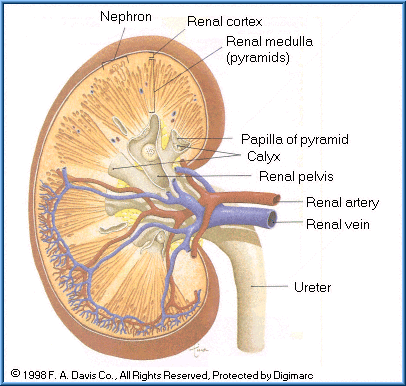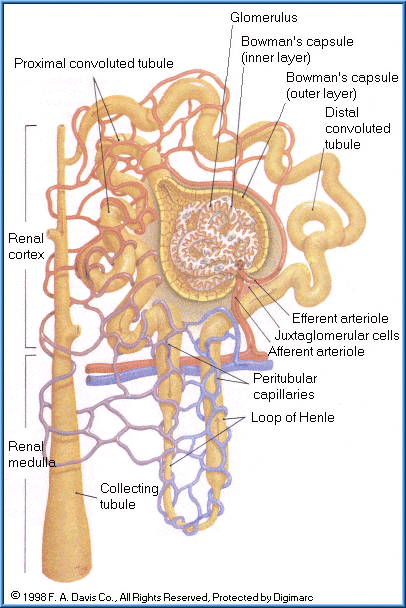|
 |
 |
 |
 |
|
|
|






Urinary Excretion

Elimination of substances by the kidneys into the urine is the primary route of excretion of toxicants. The primary function of the kidney is the excretion of body wastes and harmful chemicals. The functional unit of the kidney responsible for excretion is the nephron. Each kidney contains about one million nephrons. The nephron has three primary regions that function in the renal excretion process, the glomerulus, proximal tubule, and the distal tubule. These are identified in the illustrations.
 |
 |
 |
 |
| |

V. C. Scanlon and T. Sanders, Essentials of
Anatomy and Physiology, 2nd edition. F. A. Davis, 1995. |
|
 |
 |
 |
 |
| |

V. C. Scanlon and T. Sanders, Essentials of
Anatomy and Physiology, 2nd edition. F. A. Davis, 1995. |
|
Three processes are involved in urinary excretion: filtration, secretion, and reabsorption. Filtration, the first process, takes place in the glomerulus, the very vascular beginning of the nephron. Approximately one-fourth of the cardiac output circulates through the kidney, the greatest rate of blood flow for any organ. A considerable amount of the blood plasma filters through the glomerulus into the nephron tubule. This results from the large amount of blood flow through the glomerulus, the large pores (40 Å) in the glomerular capillaries, and the hydrostatic pressure of the blood. Small molecules, including water, readily pass through the sieve-like filter into the nephron tubule. Both lipid soluble and polar substances will pass through the glomerulus into the tubule filtrate. The amount of filtrate is very large, about 45 gallons/day in an adult human. About 99% of the water-like filtrate, small molecules, and lipid-soluble substances, are reabsorbed downstream in the nephron tubule. The urine, as eliminated, is thus only about one percent of the amount of fluid filtrated through the glomerulae into the renal tubules.
Molecules with molecular weights greater than 60,000 (which include large protein molecules and blood cells) cannot pass through the capillary pores and remain in the blood. If albumen or blood cells are found in urine it is an indication that the glomerulae have been damaged. Binding to plasma proteins will influence urinary excretion. Polar substances usually do not bind with the plasma proteins and thus can be filtered out of the blood into the tubule filtrate. In contrast, substances extensively bound to plasma proteins remain in the blood.
Secretion, which occurs in the proximal tubule section of the nephron, is responsible for the transport of certain molecules out of the blood and into the urine. Secreted substances include potassium ions, hydrogen ions, and some xenobiotics. Secretion occurs by active transport mechanisms that are capable of differentiating among compounds on the basis of polarity. Two systems exist, one that transports weak acids (such as many conjugated drugs and penicillins) and the other that transports basic substances (such as histamine and choline).
Reabsorption takes place mainly in the proximal convoluted tubule of the nephron. Nearly all of the water, glucose, potassium, and amino acids lost during glomerular filtration reenter the blood from the renal tubules. Reabsorption occurs primarily by passive transfer based on concentration gradient, moving from a high concentration in the proximal tubule to the lower concentration in the capillaries surrounding the tubule.
A factor that greatly affects reabsorption and urinary excretion is the pH of the urine. This is especially the case with weak electrolytes. If the urine is alkaline, weak acids are more ionized and thus excreted to a great extent. If the urine is acidic, the weak acids (such as glucuronide and sulfate conjugates) are less ionized and undergo reabsorption with renal excretion reduced. Since the urinary pH is variable in humans, so are the urinary excretion rates of weak electrolytes. Examples are phenobarbital (an acidic drug) which is ionized in alkaline urine and amphetamine (a basic drug) which is ionized in acidic urine. Treatment of barbiturate poisoning (such as an overdose of phenobarbital) may include changing the pH of the urine to facilitate excretion. Diet may have an influence on urinary pH and thus the elimination of some toxicants. For example, a high-protein diet results in acidic urine.
 |
 |
 |
 |
| |

V. C. Scanlon and T. Sanders, Essentials of
Anatomy and Physiology, 2nd edition. F. A. Davis, 1995. |
|
It can be seen that the ultimate elimination of a substance by the kidney is greatly affected by its physical properties (primarily molecular size) and its polarity in the urinary filtrate. Small toxicants (both polar and lipid-soluble) are filtered with ease by the glomerulus. In some cases, large molecules (including some that are protein-bound) may be secreted (by passive transfer) from the blood across capillary endothelial cells and nephron tubule membranes to enter the urine. The major difference in ultimate fate is governed by a substance's polarity. Those substances that are ionized remain in the urine and leave the body. Lipid-soluble toxicants can be reabsorbed and re-enter the blood circulation, which lengthens their half-life in the body and potential for toxicity.
Kidneys, which have been damaged by toxins, infectious diseases, or as a consequence of age, have diminished ability to eliminate toxicants thus making those individuals more susceptible to toxins that enter the body. The presence of albumin in the urine indicates that the glomerulus filtering system is damaged letting large molecules pass through. The presence of glucose in the urine is an indication that tubular reabsorption has been impaired.

  
|
|
|
|